 The Nile: Sharing a Scarce Resource
The Nile: Sharing a Scarce Resource Book contents
- Frontmatter
- Contents
- Preface
- List of Contributors
- Orthography
- Units and Conversion Factors
- Introduction
- I Environmental history of the Nile and its management
- 1 Origin and evolution of the Nile
- 2 History of Nile Flows
- 3 History of water use in the Sudan and Egypt
- 4 East Africa's water requirements: the Equatorial Nile Project and the Nile Waters Agreement of 1929. A brief historical review
- 5 History, hydropolitics and the Nile: Myth or reality
- II Nile management and factors affecting future management
- III Future utilisation of Nile waters
- IV Economic, international and legal issues
- Index
1 - Origin and evolution of the Nile
Published online by Cambridge University Press: 05 February 2012
- Frontmatter
- Contents
- Preface
- List of Contributors
- Orthography
- Units and Conversion Factors
- Introduction
- I Environmental history of the Nile and its management
- 1 Origin and evolution of the Nile
- 2 History of Nile Flows
- 3 History of water use in the Sudan and Egypt
- 4 East Africa's water requirements: the Equatorial Nile Project and the Nile Waters Agreement of 1929. A brief historical review
- 5 History, hydropolitics and the Nile: Myth or reality
- II Nile management and factors affecting future management
- III Future utilisation of Nile waters
- IV Economic, international and legal issues
- Index
Summary
Introduction
In this chapter a brief outline is given of the evolution of the River Nile. The river seems to have developed as a result of the interconnection of several independent basins and rivers. The Egyptian Nile is shown to have undergone great changes since it started excavating its channel in the late Miocene time. The shape and regimen of the extant river developed only about 10,000 years ago during the last wet phase which affected Africa after the retreat of the last glacial.
The shape of the modern Nile is a very recent development; it is but the last stage of a continuously evolving river which changed its face many times before it assumed its present configuration. The River Nile spans 5646 kilometres from Lake Victoria to the Mediterranean Sea (figure 1). The slope of the river shows marked changes passing through several gently sloping ‘landings’ which are connected by steeply-sloping rivers. Figure 2 is a longitudinal section of the river from the equatorial lakes to the sea. It shows five ‘landings’ which are from south to north: Lake Victoria, Lake Kioga and the stretches from Lake Albert to Nimule, from Juba to Khartoum and from Wadi Haifa to the Mediterranean. The stretches of the river which connect these ‘landings’ are extremely steep, obstructed by waterfalls and cataracts and youthful in appearance and age. Before the river assumed its present-day course, these different landings' seem to have formed independent basins which were disconnected.
- Type
- Chapter
- Information
- The Nile: Sharing a Scarce ResourceA Historical and Technical Review of Water Management and of Economical and Legal Issues, pp. 17 - 26Publisher: Cambridge University PressPrint publication year: 1994
- 7
- Cited by


